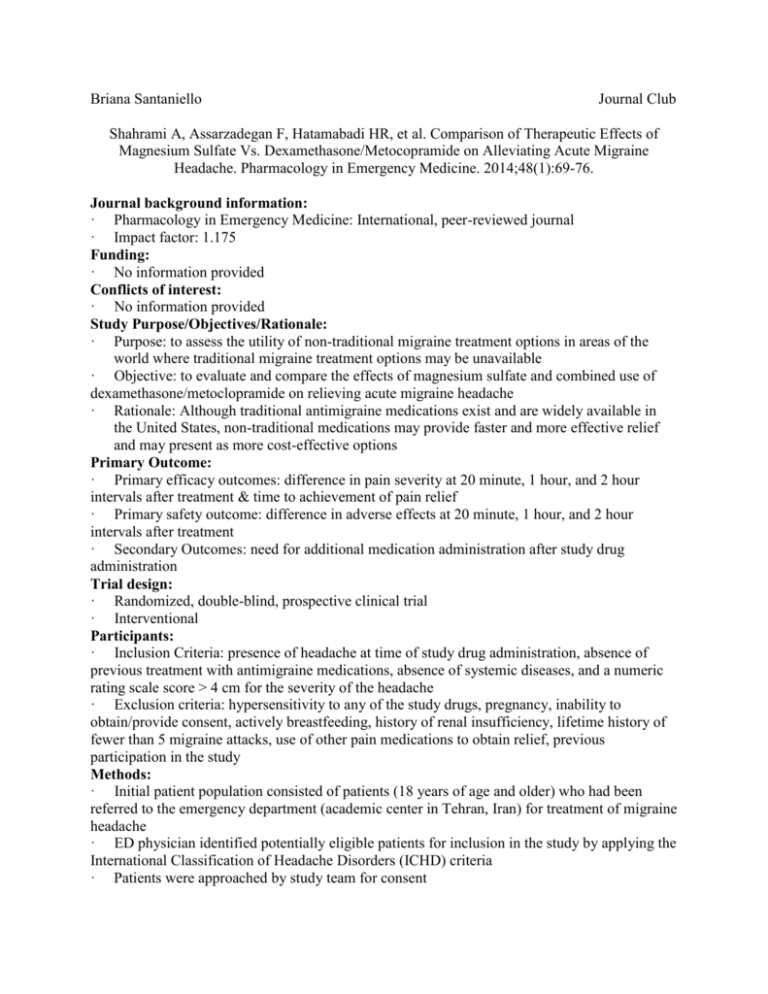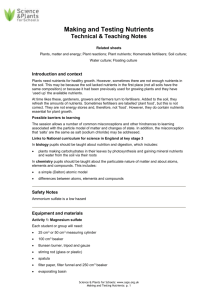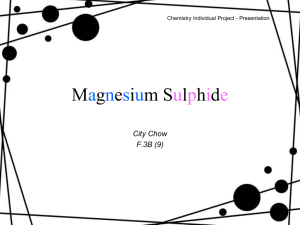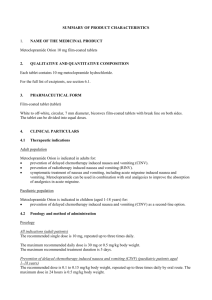Briana Santaniello Journal Club
advertisement

Briana Santaniello Journal Club Shahrami A, Assarzadegan F, Hatamabadi HR, et al. Comparison of Therapeutic Effects of Magnesium Sulfate Vs. Dexamethasone/Metocopramide on Alleviating Acute Migraine Headache. Pharmacology in Emergency Medicine. 2014;48(1):69-76. Journal background information: · Pharmacology in Emergency Medicine: International, peer-reviewed journal · Impact factor: 1.175 Funding: · No information provided Conflicts of interest: · No information provided Study Purpose/Objectives/Rationale: · Purpose: to assess the utility of non-traditional migraine treatment options in areas of the world where traditional migraine treatment options may be unavailable · Objective: to evaluate and compare the effects of magnesium sulfate and combined use of dexamethasone/metoclopramide on relieving acute migraine headache · Rationale: Although traditional antimigraine medications exist and are widely available in the United States, non-traditional medications may provide faster and more effective relief and may present as more cost-effective options Primary Outcome: · Primary efficacy outcomes: difference in pain severity at 20 minute, 1 hour, and 2 hour intervals after treatment & time to achievement of pain relief · Primary safety outcome: difference in adverse effects at 20 minute, 1 hour, and 2 hour intervals after treatment · Secondary Outcomes: need for additional medication administration after study drug administration Trial design: · Randomized, double-blind, prospective clinical trial · Interventional Participants: · Inclusion Criteria: presence of headache at time of study drug administration, absence of previous treatment with antimigraine medications, absence of systemic diseases, and a numeric rating scale score > 4 cm for the severity of the headache · Exclusion criteria: hypersensitivity to any of the study drugs, pregnancy, inability to obtain/provide consent, actively breastfeeding, history of renal insufficiency, lifetime history of fewer than 5 migraine attacks, use of other pain medications to obtain relief, previous participation in the study Methods: · Initial patient population consisted of patients (18 years of age and older) who had been referred to the emergency department (academic center in Tehran, Iran) for treatment of migraine headache · ED physician identified potentially eligible patients for inclusion in the study by applying the International Classification of Headache Disorders (ICHD) criteria · Patients were approached by study team for consent · Original ED physician subsequently established migraine headache diagnosis using ICHD criteria · Patients equally divided and randomized, using online random number generator, into one of two groups (see below) · Intervention: one group received 8 g dexamethasone and 10 mg metoclopramide in 100 mL normal saline solution infused over 15 minutes while the other group received magnesium sulfate 1 g in 100 mL normal saline infused over 15 minutes · Randomization: permutated blocks of 5 · No stratification for baseline characteristics · Double-blinding: patients were not told what treatment was being administered, clinicians were unaware of which drug was administered because three separate clinicians were involved (1 prepared the study drug, 1 administered the study drug, and 1 recorded the study results) · Study drug packages were identical and only therapeutic staff knew which study drug had been given · To protect patient safety, physicians were given the approval to order rescue medications if pain continued 20 minutes after administration of the study drug; however physicians did not become aware of the initial study drug used as no patients developed life-threatening reactions that required the unblinding of the study drug · Pain score determined using 11 scale standard NRS repeated at baseline, 20 minutes, 1 hour, and 2 hour intervals · Adverse effects recorded via self-reports of patients and clinical appearance · Sample size to detect a change of at least 2 cm in NRS scale calculated to be 62 (31 subjects in each arm) · Researchers increased sample size to 35 patients in each arm to ensure adequate power (70 patients total) Statistical Analyses: · SPS 11.5, STATA 11.0 software programs utilized · Pain severity: mean ± SD at confidence interval of 95% at baseline, 20 minute, 1 hour, and 2 hour intervals · Age differences: t-test (detects if means of the two groups are statistically different from one another—useful in comparing means of two groups appropriate choice) · Gender and treatment complications: χ2 (used to compare the data that is observed with the data that would be expected utilizing the hypothesis) · Intragroup changes of pain severity (time): ANOVA (analysis of variance: variation among observations divided into distinct components appropriate choice because of time intervals being used) · Inter-group changes of pain severity (time) ANOVA (see above) · Distribution: Kolmogorov-Smirnov test (looks at “equality of continuous, one-dimensional probability distributions that can be used to compare a sample with a reference probability distribution or to compare two samples”) · Statistical significance: p < 0.05 Results for Primary Outcomes: · 70 patients randomized into 2 groups: 35 subjects in dexamethasone/metoclopramide group & 35 subjects in magnesium sulfate group · Pain severity: o Dexamethasone/metoclopramide: 8.2 ± 1.3 (baseline) 7.4 ± 1.4 (20 min) 6.0 ± 2.4 (1 hr) 2.5 ± 2.9 (2 hrs) o Magnesium sulfate: 8.0 ± 0.9 (baseline) 5.2 ± 1.7 (20 min) 2.3 ± 1.9 (1 hr) 0.66 ± 1.3 (2 hr) o Differences between baseline and intervals for dexamethasone/metoclopramide and magnesium sulfate, respectively: baseline (p = 0.34), 20 minutes (p < 0.0001), 1 hour (p < 0.0001), and 2 hours (p < 0.0001) o Interpretation: magnesium sulfate administration is associated with statistically significant decreases in pain severity at 20 minute, 1 hour, and 2 hour intervals and thus achieves faster and more effective pain relief compared with combination dexamethasone/metoclopramide. · Adverse effects experienced by percentage of subjects in each group: o Dexamethasone/metoclopramide: 80.0% Nausea: 11.4% (4/35) Vomiting: 2.9% (1/35) Vertigo: 2.9% (1/35) Lethargy: 2.9% (1/35) o Magnesium sulfate: 88.6% Nausea: 11.4% (4/35) Results for Secondary Outcome: · Requirement of additional treatment 20 minutes after study drug administration · Dexamethasone/metoclopramide: 9/35 (25.71%) · Magnesium sulfate: 7/35 (20%) · P = 0.57 Limitations (author-identified): · Patients discharged after 2 hours if pain relief achieved in this time frame – no additional follow up performed · No placebo group – ethical considerations Limitations (student-identified): · Although p < 0.05 for differences in pain at baseline, the magnesium sulfate group had a baseline pain of 8.0 while the dexamethasone/metoclopramide group had a baseline pain of 8.2, which could influence the time to pain relief at the 20-minute mark. · Possibility of skewed results due to potential incorrect/dishonest responses during questioning about use of antimigraine agents, pain relief, etc. prior to arrival at ED · Excluded patients who did not have a lifetime history of 5 or greater migraine attacks –what was the purpose of excluding these subjects? · Percentage of subjects in each group still required additional therapy 20 minutes after the administration of the study drug, but these individuals were still included in the published results. Potential issues include 1) lower power if these subjects were not included in the final results and 2) skewed results when including these patients because the additional medication is likely what helped these patients achieve faster pain relief Conclusion: Although the results of this study appear promising, the limitations, particularly the skewed results due to the administration of additional medication after 20 minutes, shed light on the questionable effectiveness of magnesium sulfate compared with dexamethasone/metoclopramide. If the sample size of 70 had been maintained without the administration of additional medication after 20 minutes passed without pain relief after administration of the study drug, the results would then potentially be considered viable. Therefore at this time magnesium sulfate should not be given preferential recommendation over combination dexamethasone/metoclopramide. In conclusion, magnesium sulfate may represent a potential treatment option if further studies support its fast, effective pain relief in acute migraine attacks. At this time, magnesium sulfate can be considered an option in refractory migraine attacks.







